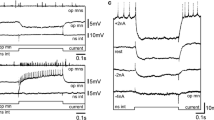Abstract
Gill motor neuron L7-induced longitudinal shortening of the gill in Aplysia kurodai and A. juliana was suppressed when extracellular stimuli were applied to a restricted dorsal central region of the abdominal ganglion. We found a neuron there which antagonized the L7-driven contraction. Since the contraction was suppressed when the identified neuron was activated simultaneously with L7, we refer to the newly found neuron as “Anti-L7”. Anti-L7 did not change the L7 impulse generation in the abdominal ganglion. No direct synaptic connection from L7 to Anti-L7 was detected. A fluorescent dye injected into the soma of Anti-L7 revealed that the neuron sent axonal branches to the branchial nerve. These results may show that Anti-L7 antagonizes L7 at the periphery inside the gill, rather than in the abdominal ganglion. EJPs induced by L7 were unaffected by Anti-L7. Activation of Anti-L7 alone did not induce any change in tone or membrane potential of the gill musculature. The suppressive effect of Anti-L7 lasts many seconds after the cessation of a train of Anti-L7 impulses. The results may suggest that the suppression is mediated through an inhibitory neuromodulatory mechanism without inhibition of L7 itself.
Similar content being viewed by others
Author information
Authors and Affiliations
Additional information
Accepted: 1 April 1999
Rights and permissions
About this article
Cite this article
Kurokawa, M., Kuwasawa, K. & Matsumura, S. Identification of an abdominal ganglion neuron antagonizing L7-driven gill contraction in Aplysia. J Comp Physiol A 185, 11–19 (1999). https://doi.org/10.1007/s003590050361
Issue Date:
DOI: https://doi.org/10.1007/s003590050361




